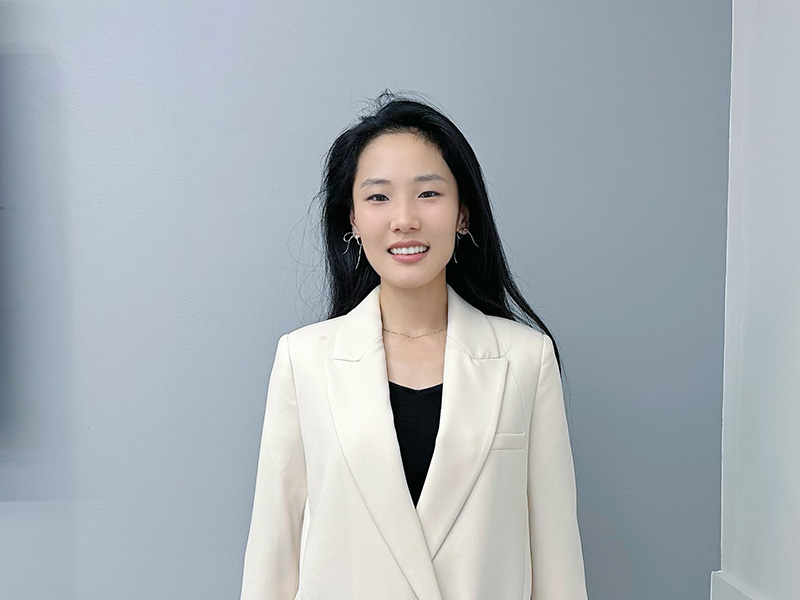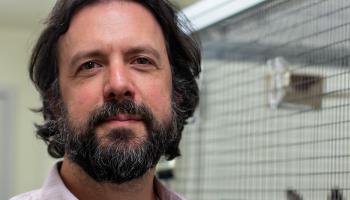Could Songbirds Make Us Better Tennis Players?

If you’re thinking it’s easier to learn something new in a quiet environment, you’d be wrong. At least, that’s the case if you’re a zebra finch.
In a recent study published in the Journal of Neuroscience, Yao Lu, a Ph.D. candidate in psychology in UVA’s College and Graduate School of Arts & Sciences, presented her findings that zebra finches, a variety of songbird found primarily in Australia and Indonesia, learn to recognize and sing songs best under noisy conditions. Her research has also offered some surprising insights into the nature of neuroplasticity or the ability of the brain to change in response to new information, findings that could someday help athletes develop better muscle memory, help victims of strokes or other neurological damage recover more quickly and could even lead to advances in artificial intelligence.
In her fifth year with the Department of Psychology, Lu studies systems and behavioral neuroscience, which focuses on the development of sensory systems and the influences of experience on learning and memory. A member of the department’s Meliza Lab, she works with zebra finches studying the connection between the brain’s mechanisms for auditory learning and perception and for vocal communication.
Like many other songbirds, zebra finches live in large groups with dynamic social structures, and they use song to communicate their individual identity, their sexual fitness and a variety of other types of information that are important to the survival of their flocks. Zebra finch communities can be noisy, but despite that, younger members can learn to recognize and sing hundreds of different songs from their parents and others in their social group. For Lu, their ability to recognize important information and to use it to develop useful social behaviors can provide researchers with insight into the neural processes underlying speech perception and similar kinds of learning. Understanding how those abilities are learned could also be a key to understanding language development in humans.
“Just like human babies, zebra finches learn to speak by imitating their parents, and we’re trying to understand how the brain accomplishes this,” Lu said. “We’re also trying to understand how the brain differentiates speech from background noise.”
“There is a critical window during the early stages of an animal’s life,” Lu added. “If the animal misses the proper stimulus, their sensory abilities don’t develop properly.”
Researchers interested in understanding neural plasticity focus, primarily, on understanding a phenomenon known as synaptic plasticity, which is the ability of neurons to modify their connections to each other, as they can do after brain tissue is damaged by a stroke, for example. However, Lu focuses on intrinsic plasticity, or changes in the membranes of the neurons themselves, changes that are also involved in the learning process but are not as well understood.
Juvenile finches that are raised in noisy environments, Lu found, benefitted from more rapid intrinsic plasticity than those raised in quiet environments, which she discovered by observing the changes in the characteristics of the functions of their neurons.
“Finches are social animals,” Lu said. “Naturally, there are background noises in their environment. They talk constantly, so that’s their natural learning condition. Their auditory circuits are bombarded by noises, and the more noise there is, the more challenging it is for them to recognize the songs they need to learn.”
Lu hypothesized that there had to be some mechanism capable of dampening what she calls “the noise-induced overexcitation of the finches’ brains,” and that a decrease in that intrinsic excitability could be a way for them to adapt to the noisy conditions in which they live. And her research supports her assumption.
“The more their neurons have fired in the past, the less they’ll tend to fire in the future,” Lu said, and that decrease in the firing of the neurons, she finds, could be what helps them filter the songs they need to hear and learn from the noise around them. It may also help them better regulate the brain functions in charge of their auditory systems, how they learn from other zebra finches and how they learn to communicate more effectively themselves.
Discoveries like this may, one day, better inform how neurons function in concert and how neuroplasticity occurs at the cellular level and the role they play in learning, “but we’re not quite there yet,” Lu said.

Lu’s advisor, associate professor of psychology, Dan Meliza, award-winning director of UVA’s Meliza Lab whose own research is concerned with the neural mechanisms of auditory learning and perception, believes she’s on the right track.
“We know that one of the most critical periods in human life is the first year. One of the most important things that happens during this time is that the infant’s brain forms a neural map of the sounds of the languages its parents or caregivers speak. This map enables the growing child and eventually the adult to decode speech and to replicate those patterns accurately, flexibly and consistently when producing speech. Although the field has a broad sense of when this neural map forms, how this works in the brain and how it goes wrong in language learning disorders like dyslexia remain poorly understood. Yao’s paper is an important step towards answering some of these questions,” Meliza said.
And while Lu’s work may eventually help scientists understand how humans learn language, it could also play a part in helping improve the machine learning algorithms that we know as artificial intelligence, said Lu whose work has won her a Presidential Fellowship in Collaborative Neuroscience from UVA’s Brain Institute, which aims to facilitate cross-disciplinary research in neuroscience.
Artificial neural networks, or ANNs, a component of machine learning models, are also capable of learning, and the connections those computational models make as they encounter and evaluate new information are inspired by the way our own brains work. ANNs utilize computational “nodes,” – also known as “artificial neurons” – to evaluate inputs and generate outputs. While these artificial neurons aim to capture the essence of how neurons adapt, they are highly simplified, and Lu feels that a better understanding of the internal plasticity of neurons may also lead to new advances in the learning algorithms of these artificial networks.
An avid tennis player and sports enthusiast, Lu is also interested in how neuroscience might be used to train athletes.
“One of my tennis partners is really good,” Lu said. “He grew up playing the game, and I feel like there’s also a critical period for the development of that kind of muscle memory: the earlier you learn it, the easier it is to progress later in life.”
Lu also envisions developing a way to record the neural activity of professional athletes to better understand the differences between how the brain controls the muscle functions for an experienced athlete and for a beginner.
Ultimately, she sees the potential to create a system that could accelerate athletic training by recording how the muscles are moving and what the neurons are doing in more advanced athletes and using that information to help less experienced athletes develop the automatic responses, or the muscle memory, necessary to play a sport at a higher level.
“Playing tennis well is much more than having a coach tell you where your arms should be or what angle to hold your wrist,” Lu said. “So much of learning any sport is beyond language.”







